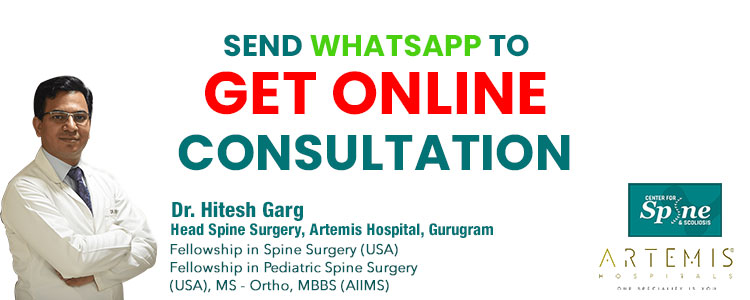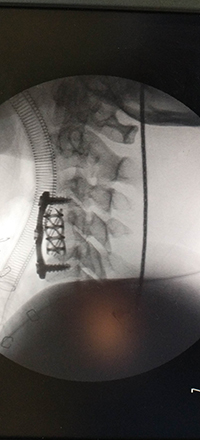
Your orthopaedic surgeon or neurosurgeon may recommend cervical spine surgery to relieve neck pain, numbness, tingling and weakness, restore nerve function and stop or prevent abnormal motion in your neck.
Your surgeon does this by removing a disc or a bone and fusing the vertebrae together with a bone graft either in front of or behind the spine.
Sometimes metal plates and screws are also used to further stabilize the spine. These techniques are called instrumentation. When the vertebrae have been surgically stabilized, abnormal motion is stopped and function is restored to the spinal nerves. An alternative to spinal fusion is a cervical disc replacement using an artificial disc that enables neck motion and stabilizes the spine.

Various ailments of cervical spine are treated through anterior or posterior or both anterior plus posterior approaches as per the need. Anterior cervical surgery is done with a very small cosmetic incision using surgical microscope to remove and replace the diseased disc or vertebra at one or multiple levels.
As no muscles are cut during the exposure there is minimal blood loss, less pain after surgery and faster recovery. Posterior approach is used to deal pathology like cranio-cervical instability, C1-C2 instability and cervical spine instability due to trauma, infection or rheumatoid arthritis. Patients start walking the evening of surgery and can start their routine activity as early as 15 days after surgery.
Cervical spine surgery may be indicated for a variety of spinal neck problems. Generally, surgery may be performed for degenerative disorders, trauma or instability. These conditions may produce pressure on the spinal cord or on the nerves coming from the spine.
The success rate of cervical spine surgery is very high, but complications have been reported.
While dural tear (a tear in the protective covering of the spinal cord) is the most common neck surgery complication, its total incidence is only 0.77%. C5 palsy (a temporary paralysis in one or both arms) is the second most common complication, with a total incidence of only 0.42%.
While complications are generally quite rare, you may be at a higher risk for certain complications based on the type of neck surgery you undergo.
For example, neck surgery complications frequently involve the esophagus. Patients undergoing an anterior cervical discectomy and fusion (ACDF) are at a higher risk of dysphagia (difficulty swallowing), nerve injury in the larynx (voice box), and pharynx wall swelling.
As with any procedure, there are risks associated with neck surgery. Your doctor will discuss the potential risks of the procedure with you prior to surgery. Some risks related to neck surgery can include:
Additionally, the procedure may not work to relieve your pain or other symptoms, or you may need to have additional neck surgeries in the future.
you can do your part to improve your surgery’s success by discussing your risks and benefits with your surgeon before undergoing your procedure.
“Each patient is unique, and careful pre-operative planning is a key for the successful surgery”. “It is important to evaluate spine pathology [cause of disease or disorder] and any other comorbidities, such as smoking, diabetes, and mental disorders. Patients should discuss their conditions with their surgeon, and how they might impact both the fusion success and a chance of post-operative complications.”
Cervical spinal fusion joins two of your vertebrae into a single, stable piece of bone. It’s used in situations where an area of the neck is unstable, or when motion at the affected area causes pain.
ACDF is a type of surgery that’s done to treat a pinched nerve or spinal cord compression.
The surgeon will make the surgical incision at the front of your neck. After making the incision, the disk that’s causing the pressure and any surrounding bone spurs will be removed. Doing this may help relieve the pressure on the nerve or spinal cord.
A spinal fusion is then performed to give stability to the area.
The purpose of a laminectomy is to relieve pressure on your spinal cord or nerves. In this procedure, the surgeon makes the incision at the back of your neck.
Once the incision is made, the bony, ridged area at the back of the vertebra (known as the lamina) is removed. Any disks, bone spurs, or ligaments that are causing compression are also removed.
A laminoplasty is an alternative to laminectomy to relieve pressure on the spinal cord and associated nerves. It also involves an incision on the back of your neck.
Instead of removing the lamina, the surgeon creates a door-like hinge instead. They can then use this hinge to open up the lamina, reducing compression on the spinal cord. Metal implants are inserted to help keep this hinge in place.
The advantage of a laminoplasty is that it preserves some range of motion and also allows the surgeon to address multiple areas of compression.
This kind of surgery can treat a pinched nerve in your neck. The surgeon will make the incision at the front of your neck.
During ADR, the surgeon will remove the disk that’s applying pressure to the nerve. They’ll then insert an artificial implant into the space where the disk was previously located. The implant may be all metal or a combination of metal and plastic.
Unlike ACDF, having an ADR surgery allows you to retain some of the flexibility and range of motion of your neck.
Generally speaking, you can expect to spend a day or two in the hospital following your surgery. Exactly how long you’ll need to stay in the hospital will depend on the type of surgery you’ve had.
Often, neck surgeries require only night, whereas lower back surgeries typically require longer stays.
It’s normal to feel pain or discomfort while recovering. Your doctor will likely prescribe medication to help relieve your pain.
Most people can typically walk and eat the day after their surgery.
Neck surgery isn’t the first option for treating neck pain. It’s typically only recommended when less invasive treatments aren’t effective.
There are some types of neck conditions that are more often associated with neck surgery. These include issues like pinched nerves, compression of the spinal cord, and severe neck fractures.
There are several different types of neck surgery, each with a specific purpose. If surgery is recommended for the treatment of your neck condition, be sure to discuss all your options with your doctor.
feel free to contact us!